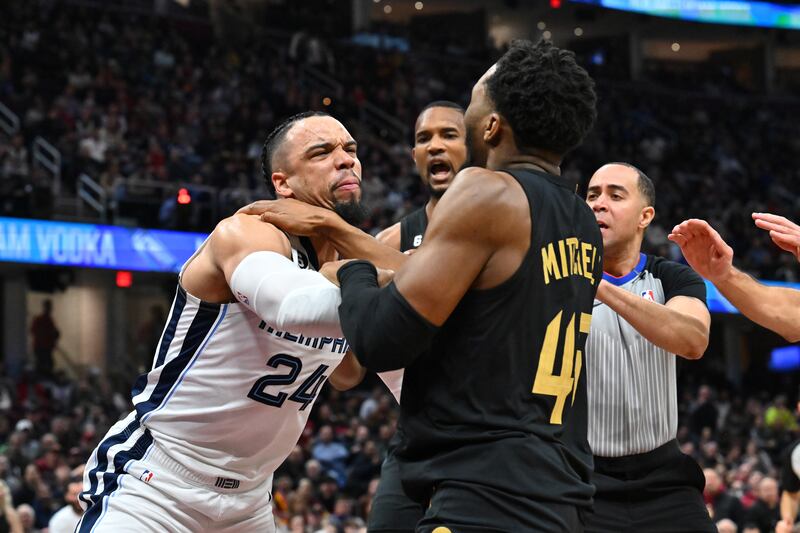Dillon Brooks’s highlight reel is like no other in the NBA. Here’s the Memphis Grizzlies’ small forward clattering into and shoving an innocent sideline cameraman. There he is punching the Cleveland Cavaliers’ Donovan Mitchell in the testicles during a tussle underneath the basket. Everywhere there is footage of him jawing at and needling opposing players, coaches, and benches, a relentless stream of goading, gurning, and gesticulating. At one point during a free throw, he approaches every Golden State Warrior on the court to spew abuse in their ears.
The title of most hated player in any league is hard-won, but Brooks seems to have earned the accolade. This season alone, he’s been fined $250,000 for offences ranging from amassing 18 technical fouls in the campaign to calling a Dallas Mavericks’ veteran a cheerleader. That the 27-year-old Canadian revels in his growing reputation as a master of the dark arts and trash-talker supreme can be gleaned by his facial expression for the Grizzlies’ official team photo. Where everybody else is smiling broadly, he offers up his most sinister stare, glaring down the lens. As if auditioning hard for the role of heel.
“It’s not a job everybody wants,” said Brooks. “And that’s what makes me different. Guys don’t like dealing with the physicality. They don’t like to get bumped. They don’t like having someone in their space all night.”
For his uncanny ability to pester players with more talent than him, and his happy knack for throwing them off their games, Brooks is paid $12 million a year on a Grizzlies’ team who enter the forthcoming play-offs as the number two seed in the Western Conference. Averaging 14 points per game, he’s also reckoned by some to be the best perimeter defender in the sport. Not everybody acknowledges that, because cameras tend to focus on him exaggeratedly celebrating stops, usually in the faces of stricken opponents. The media often appear distracted, too, by his constant chuntering at everybody within earshot – an approach that has made him many enemies.
READ MORE

“If you ever wondered why the Memphis Grizzlies are not ready to compete for a championship, look no further than this idiot right here,” said Draymond Green of the Golden State Warriors, the team arguably most tired of Brooks’s schtick. “They actually are depending on this guy to help them win a championship, and he says: ‘His game is cool.’ Quite frankly, that just shows how little you know about basketball. I’m not sure why they like you in Memphis.”
[ Dave Hannigan: American conservatives bid to censor stories of struggleOpens in new window ]
They like Brooks because he gets under the skin of the biggest scorers on opposing teams, and some neutrals are bizarrely fond of his pantomime antics too. Plenty of old-timers in the audience regard Brooks’s nefarious carry-on as a welcome throwback to more combative eras like the 1980s and 1990s, when the NBA was a much less polite and more intimidating league.
I like getting booed. I like guys against me. It gets me going even more
Back then, rivals didn’t embrace in the middle of the court at the end of games and yuck it up exchanging shirts, never mind vacationing with each other’s families in the off-season. Bad blood was more likely to be spilt on the floor than on social media, punch-ups were de rigueur, and every play-off match came replete with a feuding storyline, lingering enmity and genuine personal vendettas. Witness Michael Jordan keeping Isiah Thomas off the Dream Team for the 1992 Barcelona Olympics in the ultimate revenge move.
“There is nothing delicate about the way Dillon Brooks plays basketball,” wrote Tim Keown on ESPN.com. “He grabs and shoves, bumps with shoulders and checks with hips. He charges through screens with the refinement of a brick through a window, sure to get two hands (at least) on everyone in his path. There are many, many times when the contacts lasts just a little too long and is just a little rougher than necessary. Being guarded by him is like wearing a human body – a large, strong, sweating human body – for the best part of two hours.”
Brooks grew up in Mississauga, a middle-class suburb of Toronto not known for producing future NBA stars. For his final year of high school, h
e transferred to Findlay Prep in Henderson, Nevada, reputedly more of a basketball factory than an educational institution.
He moved countries to enhance his chances of snagging a scholarship to a major American college and, when the University of Oregon came calling, he didn’t even know where the state was on the map. No matter: he was soon 6ft 7ins and making such a notorious impact in college ball that one headline dubbed him “Villain Brooks”.
There is nothing delicate about the way Dillon Brooks plays basketball. He charges through screens with the refinement of a brick through a window
A school of thought contends that Canadians who make it to the show always have a chip on their shoulder about being judged differently from their American counterparts. Drafted 45th in the 2017 Draft by the Grizzlies, Brooks became a starter just eight games into his rookie season, an indicator that he possesses serious talent beyond his knavish persona. The arch-villainy also disguises the fact he forensically prepares for each defensive assignment, poring over video of opponents so he knows their every tendency with ball in hand. He is as diligent about his task as he is dastardly.
“I like getting booed,” said Brooks. “I like guys against me. It gets me going even more. Just staying on the playbook and focusing on the game. I already know it’s going to come. It doesn’t faze me.”
Just as well.

















